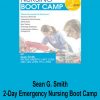Sean G. Smith – 2-Day Emergency Nursing Boot Camp
Original price was: $299.00.$80.00Current price is: $80.00.
Compare- Description
Description

Sean G. Smith – 2-Day Emergency Nursing Boot Camp
Critical Interventions & Actions for:
- Trauma’s Lethal Triad
- Penetrating Chest Traumas
- SIRS & Sepsis
- Burn Trauma
- Toxicology Challenges
- Cardiovascular & Neuro Emergencies
You have the daunting challenge of recognizing subtle changes in a patient’s condition that can lead serious complications or even death. Are you sure you have the knowledge and skills you need to handle these difficult situations?
Working in the rapidly-changing emergency department and caring for the most complex patients means you have to be able to recognize these changes and respond appropriately. You’re dealing with life-threatening conditions and you need to be up to date on the most current and cutting-edge strategies. During this comprehensive program you will gain the skills you need to manage any situation. Drawing on over 20 years of experience, Sean G. Smith, RN, BSN, NREMT-P, C-NPT, CCRN, CMC, CEN, CFRN, FP-C, CPEN, will challenge you to take your knowledge to the next level!
OUTLINE – DAY ONE
Trauma’s Lethal Triad: Hypothermia, Acidosis & Coagulopathy Hypothermia
- Correct Classification of the Trauma Patient
- Contributing Risk Factors
- Volume Resuscitation
- Why, When & How to Use IV Fluids
Acidosis
- What is Happening & Why?
- Panic Values & Lethal Levels
- Oxyhemoglobin Dissociation Curve
- Left & Right Curves
- Why it Matters
Coagulopathies
- Understanding a Very Complex Process
- Effect on Body Systems
- When it Goes Wrong
- DIC: Disseminated Intravascular Coagulopathy
- Understanding the Lab Values
- CBC, Platelets, PT, PTT, D-dimer, Fibrin
- Hemorrhagic Shock
- Permissive Hypotension
- Damage Control Resuscitation
- Understanding the Lab Values
Putting it All Together
- Simple Steps that SAVE Lives
- Management & Treatment Options
Burn Trauma
- Critical Assessments during the Primary Survey
- Key Components of the Secondary Survey
- Fluid Resuscitation Formulas
- American Burn Association Evaluation Criteria
- Treatment Strategies for Chemical, Electrical & Thermal Burns
- ‘Never Miss’ Clues for Identifying Inhalation Injuries
The Septic Patient
- SIRS: Systemic Inflammatory Response Syndrome & SEPSIS
- Inflammatory Response: A Good Thing
- SIRS: Too Much of a Good Thing
- Sepsis & Severe Sepsis: Too Much of a Good Thing Comes to a Bad End
- Patient Presentations along the Continuum
- Sepsis Surveillance
- Emergent Interventions: Time is Tissue
OUTLINE – DAY TWO
Penetrating Chest Traumas
- FAST Evaluation & Ultrasound
- Pneumothorax
- Variations & Identifying Symptoms
- Emergency Interventions
- Flail Chest
- Dos & Don’ts of Initial Management
- Special Populations at Risk
- Cardiac Tamponade
- Thoracotomy in the ED
Cardiovascular Emergencies
- Advanced Hemodynamics
- SVR: Systemic Vascular Resistance
- CVP Monitoring
- The Spectrum of Acute Coronary Syndrome
- Key Assessments & Interventions for:
- Unstable Angina
- STEMI
- Non-STEMI
- Recognizing Arrhythmias
- Stable, Unstable and Lethal
Neuro Emergencies: Time is Brain
- Concepts of Volume & Pressure
- Rapid Neuro Assessment
- Critical Interventions for:
- TBI
- Spinal Cord Injuries
- Diffuse Axonal Injury
Toxicology Challenges
- Identifying the Toxin
- Assessment of Intentional & Unintentional Overdose
- ABGs – a Critical Key
- Treatment Options: Removing & Reducing Causative Agent
- Symptom Management Strategies When There is No Curative Agent
- Toxicology Arrhythmias: Expected & Unexpected
- Today’s Street Drugs
Life-Threatening Electrolyte Imbalances
- Critical Clues for Quick Identification
- Panic Values
- Interventions that Improve Outcomes
- Potential Causes & Treatments
OBJECTIVES
- Interpret patterns of ischemia, injury and infarction on a 12-lead EKG.
- Discuss cardiac disorders which carry an increased risk for sudden death.
- Describe the relationship between ventilation and perfusion.
- Identify conditions which would require a chest tube.
- Recognize assessment findings in clinical syndromes that may progress rapidly and cause life-threatening conditions.
- Define the anatomy and physiology of the neurological system and how this manifests in physical symptoms.
- Recognize life-threatening electrolyte imbalances, potential causes and remedies.
- Interpret arterial blood gasses using a three-step method.
- Compare and contrast the oxyhemoglobin dissociation curve to pulse oximetry readings, So2 and pO2 values.
- Evaluate signs, symptoms and treatment modalities for four different classifications of shock.
- Describe systemic inflammatory response syndrome and the spectrum of septic shock.
- Correlate clinical presentations of patients during the continuum of SIRS to septic shock.
- Discuss the coagulation cascade and laboratory values associated with disruption of normal function.
ADA Needs
We would be happy to accommodate your ADA needs; please call our Customer Service Department for more information at 1-800-844-8260.
Satisfaction Guarantee
Your satisfaction is our goal and our guarantee. Concerns should be addressed to: PO Box 1000, Eau Claire, WI 54702-1000 or call 1-800-844-8260.










